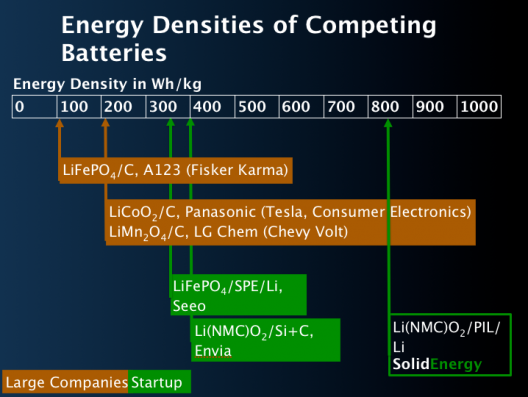Take two Massachusetts Institute of Technology (MIT) business incubator realizations, mix their strengths and watch for the potential breakthroughs that could come in the form of high-energy-density batteries.
According to its web site, “SolidEnergy is developing a safe, high energy density, and wide temperature capable rechargeable battery that has the potential to transform the consumer electronics, electric vehicle, and downhole exploration (as in well drilling) industries. The core technology is called a Solid Polymer Ionic Liquid (SPIL) lithium metal battery.”
Founded in 2012, “one of the toughest years in the battery industry,” SolidEnergy’s “…objective is to develop an insanely great next generation battery and commercialize it in the fastest and most efficient way.”
This decidedly brash approach needs a steadying hand at the wheel, which is where its partnership with A123 Systems comes into play.
A123’s first collaboration under its expanded research and development model combines SolidEnergy’s SPIL technology with “the mature cell design and prototyping capabilities of A123.”
This would help SolidEnergy’s founder, Dr. Qichao Hu bring his 800 Watt hour per kilogram batteries — twice that of state-of-the-art batteries and four times the energy density of conventional lithium-ion batteries, to market quickly.
According to Green Car Congress, “The companies plan to jointly produce consumer electronics battery prototypes within the next year, followed by electric vehicle battery prototypes. SolidEnergy staff will also be hosted in A123’s Waltham, Massachusetts development facility. Test results are expected to be ready for discussion with target customers in the latter part of 2014.”
SolidEnergy concentrates on a “novel” electrolyte and a solid-polymer-coated lithium anode in their quest to boost energy density and cycle life. SPIL, their ionic liquid polymer, is claimed to provide safety and a wide temperature capability, while the anode extends energy density and cycle life by preventing dendrite growth. The technology is “compatible with current and future cutting-edge cathodes.”
Claiming the ability to work in temperatures from -40°C to 300°C, the new batteries could simplify the need to heat or cool batteries under extreme conditions and extend range and cycle life normally reduced by heat or cold.
To see Dr. Hu’s patent, click here. To see his doctoral dissertation, “Electrode-Electrolyte Interfaces in Solid Polymer Lithium Batteries,” click here.

